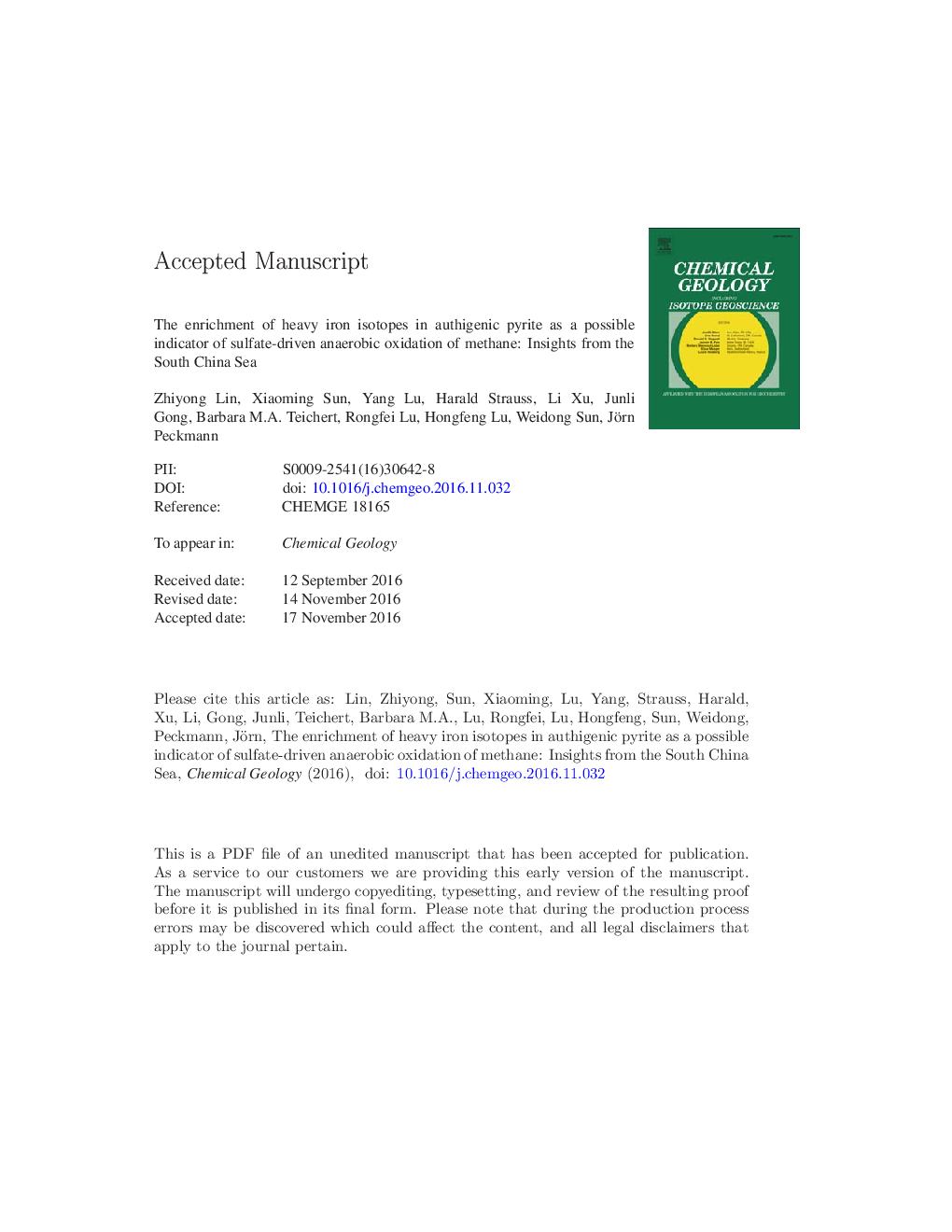| کد مقاله | کد نشریه | سال انتشار | مقاله انگلیسی | نسخه تمام متن |
|---|---|---|---|---|
| 5782776 | 1637525 | 2017 | 45 صفحه PDF | دانلود رایگان |
عنوان انگلیسی مقاله ISI
The enrichment of heavy iron isotopes in authigenic pyrite as a possible indicator of sulfate-driven anaerobic oxidation of methane: Insights from the South China Sea
ترجمه فارسی عنوان
غنی سازی ایزوتوپهای سنگین آهن در پرییت اگزوژنیک به عنوان شاخص احتمالی اکسیداسیون بی هوازی متان توسط سولفات متان: بینش از دریای چین جنوبی
دانلود مقاله + سفارش ترجمه
دانلود مقاله ISI انگلیسی
رایگان برای ایرانیان
کلمات کلیدی
ایزوتوپهای آهن، پریت، ایزوتوپهای گوگرد، اکسیداسیون بی هوازی متان توسط سولفات، دریای چین جنوبی،
موضوعات مرتبط
مهندسی و علوم پایه
علوم زمین و سیارات
ژئوشیمی و پترولوژی
چکیده انگلیسی
Sulfate-driven anaerobic oxidation of methane (SO4-AOM) and organiclastic sulfate reduction (OSR) in marine sediments commonly lead to the precipitation of authigenic pyrite with characteristic sulfur isotopic compositions. Yet, no reports on the iron isotopic composition of SO4-AOM generated pyrite exist to the best of our knowledge and the processes controlling the distribution of iron isotopes during this biogeochemical process are not understood. To investigate the mechanisms involved in iron isotope fractionation during SO4-AOM, we analyzed the isotopic composition of authigenic pyrite from two seafloor sites (HS148 and HS217) in the Shenhu gas hydrate area, South China Sea. The δ56Fe values of pyrite were found to vary from â 0.349â° to + 0.267â° in core HS148, and from â 0.793â° to + 0.178â° in core HS217 (relative to average igneous rock) with distinct trends towards higher values with increasing burial depth in both cores. The δ56Fe values correlate positively with the extent of pyritization (Fepy/FeHR) derived from a sequential iron extraction procedure. OSR was found to drive early diagenetic pyrite formation at shallow depth, resulting in relatively 56Fe depleted pyrite. Peaks in the extent of pyritization of 0.45 and 0.47 at ca. 6 and 7 m below the sediment surface, respectively, correlate with high δ56Fe and high δ34S values, and are interpreted to reflect periods of enhanced SO4-AOM in paleo-sulfate methane transition zones (SMTZs). The great variability in iron isotopic composition and the observed trends are best explained as a function of the availability of dissolved sulfide, reflecting sulfide formation by OSR and SO4-AOM. The successive conversion of reactive iron to pyrite via sulfidization apparently resulted in the enrichment of 56Fe in the iron reservoir upon the preferential consumption of isotopically light iron, leading to the formation of successively 56Fe-enriched pyrite especially at or in close proximity to the SMTZ. Therefore, we hypothesize that the combined enrichment of heavy iron isotopes and 34S in authigenic pyrite is a possible tracer of SO4-AOM in modern and ancient sedimentary sequences.
ناشر
Database: Elsevier - ScienceDirect (ساینس دایرکت)
Journal: Chemical Geology - Volume 449, 20 January 2017, Pages 15-29
Journal: Chemical Geology - Volume 449, 20 January 2017, Pages 15-29
نویسندگان
Zhiyong Lin, Xiaoming Sun, Yang Lu, Harald Strauss, Li Xu, Junli Gong, Barbara M.A. Teichert, Rongfei Lu, Hongfeng Lu, Weidong Sun, Jörn Peckmann,
